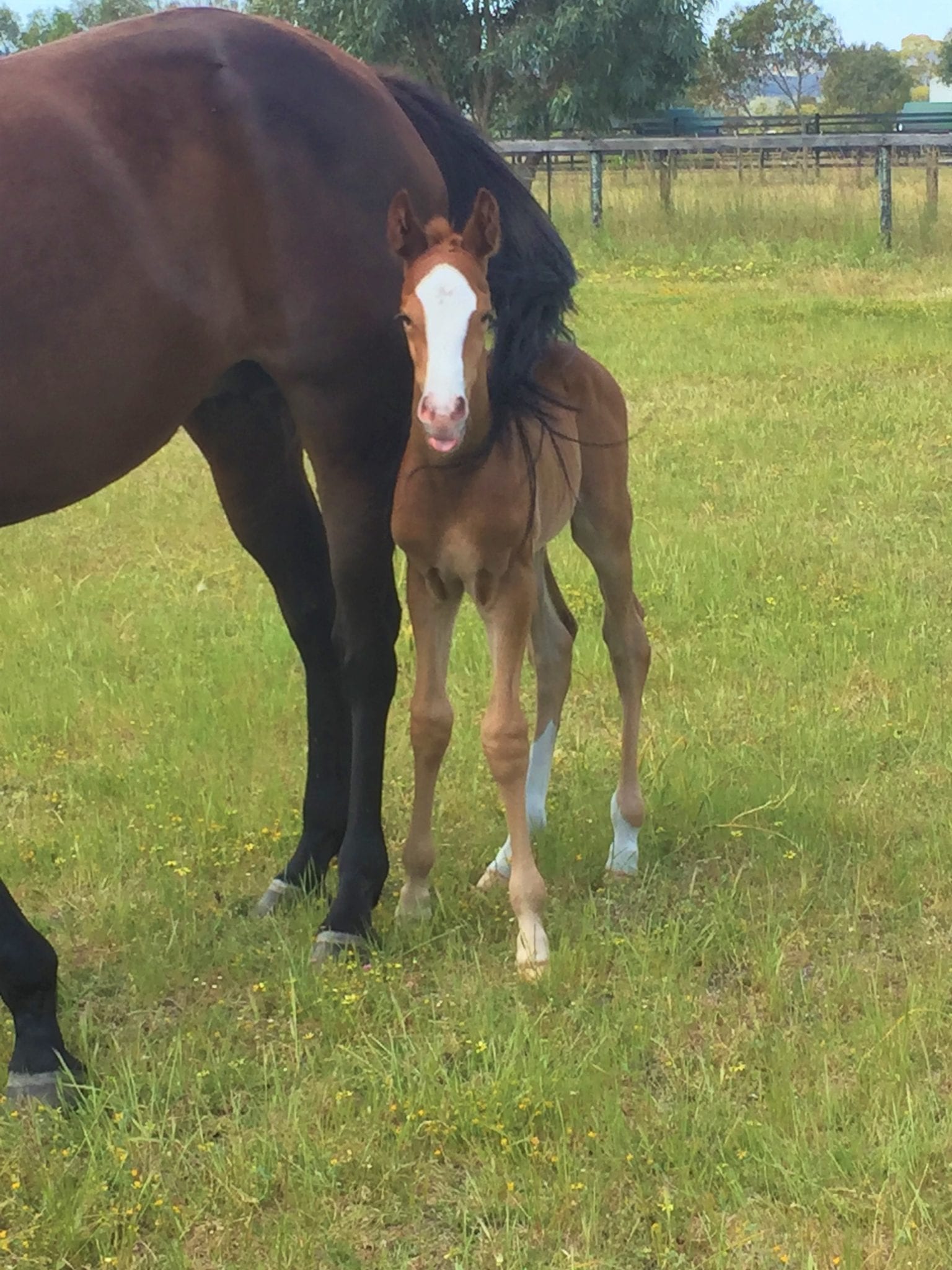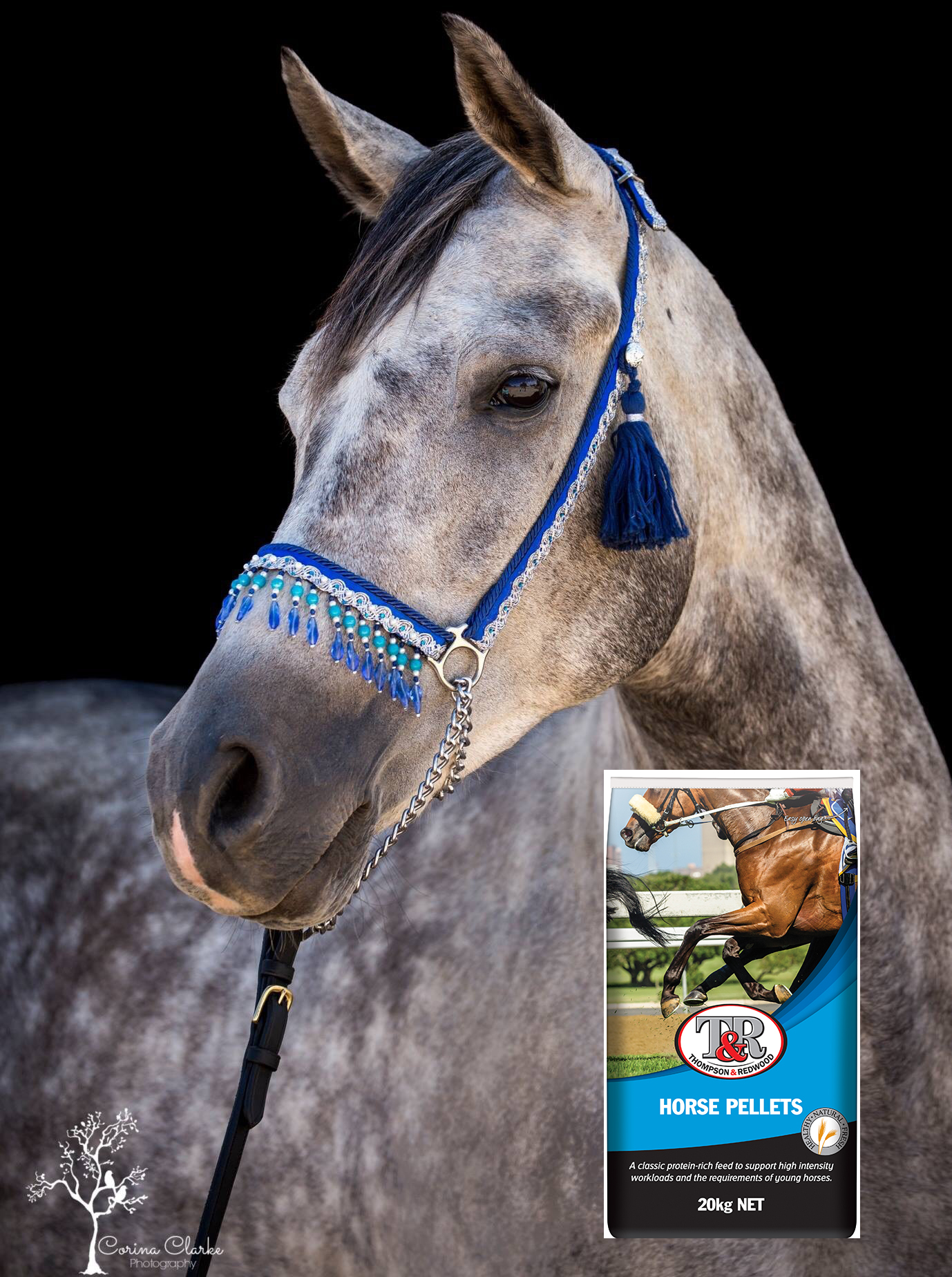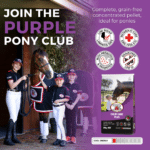
From grass roots to high performance, we have an equine feed to suit
A feed for (almost) every animal on the farm
Quality
Ruminant feeds to support productivity
We’re passionate about poultry
superior feed for broodmares, young stock & commercial studs
with added pre & probiotics
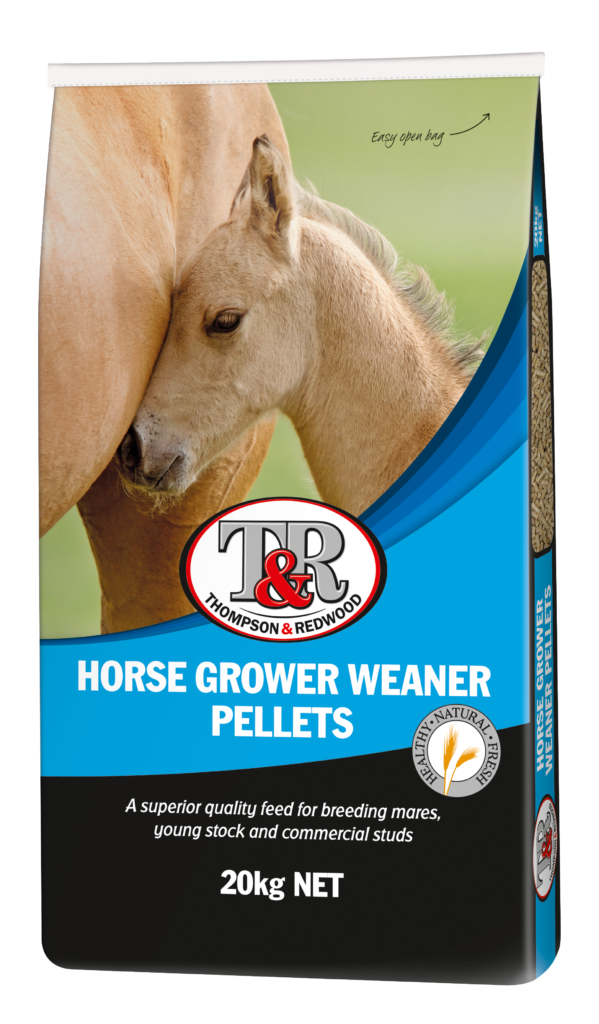
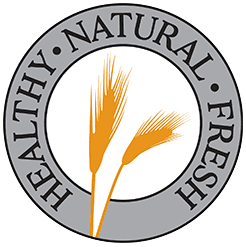
Making healthy, natural and fresh stock feed since 1985
Thompson & Redwood makes affordable and nutritionally balanced stock feed for the horse and agricultural
industries. Our recipes never change and are milled daily from Western Australian grain so you know what
you’re feeding is healthy, natural and fresh.
What's your
horse feeding challenge?
- Fizzy horse?
- Poor keeper?
- At risk of laminitis?
Let our veterinary and nutrition team support you and your horse with our carefully formulated complete horse feeds.
Find the feed most suited to your horse or pony.
What's your
horse feeding challenge?
- Fizzy horse?
- Poor keeper?
- At risk of laminitis?
Let our veterinary team support you and your horse with our carefully formulated complete horse feeds.
Find the feed most suited to your horse or pony.
35 years old, happy and healthy - Happy Retirement Rusty!
Rusty has taught so many kids to ride, and is now enjoying his days of retirement with Horse Cubes for Seniors and Lupin Fibre Cubes together as a nutritious mash.
#horsecubesforseniors #lupinfibreboost #oldpony #horsefeed #fuelledbytandr
Apr 22

ULCERS - Feeding strategies for prevention and care ️
Did you know that one Western Australian study found that 53% of horses had ulcers? Ulcers can lead to pain, reduced appetite, decreased performance and more. Here are some important feeding strategies that can help with prevention and care:
✅Saliva helps to buffer the acid and protect the gut, and the more they chew, the more saliva they produce! Offer plenty of ad-lib forage and fibre, day and night to keep them producing saliva and their gut functioning. 💡𝗗𝗶𝗱 𝘆𝗼𝘂 𝗸𝗻𝗼𝘄: Horses only produce saliva when chewing.
✅ Provide ad lib forage and try to keep time without available feed to a minimum. If you are worried about weight gain, limit the quality of roughage, not quantity.
✅ Look for feeds that are high in fermentable fibres and low in starches and sugars. Our Lupin Fibre Boost and Lupin Fibre Cubes are both very low in starch and high in fermentable fibres so suitable for horses with ulcers.
✅ Split your hard feeds or concentrates into as many small feeds per day as you can. More smaller feeds are better for their stomach than few large feeds.
✅ Ensure they are always well hydrated.
✅ Avoid riding on an empty stomach. Offer a small feed of lucerne hay or chaff immediately prior to riding to help prevent acid splash.
✅ Provide lots of turnout time and grazing if you can – turning your horse out helps to decrease stress, especially if they have other horses around them. Grazing also helps horses to keep producing saliva which helps to buffer the stomach.
If you suspect your horse has ulcers, please seek veterinary advice. The sooner you seek help, and your horse gets treatment, the sooner your horse can return to optimum health.
Looking for an ulcer-safe feed? Lupin Fibre Boost, Lupin Fibre Cubes and Calm Care Plus are all low in sugar and starch and safe for horses with ulcers.
#tiptuesday #ulcers #horseulcers #ulcercare #lowsugarandstarch #horsefeed #horsecare
Apr 21

Meet Milan and Hashie...you might recognise them from our Lupin Fibre Boost bag! Well they are on their way back across the Nullarbor after a successful Grand Nationals, and Hashie is staying hydrated with a nice sloppy Lupin Fibre Boost mash.
#lupinfibreboost #fuelledbytandr #horsefeed
Apr 17

HOOVES - How does feeding influence hoof health?
No hoof no horse! Hoof health can be influenced by 3 key things – GENETICS, ENVIRONMENT and NUTRITION. What you feed can make all the difference to keeping your horse`s hooves strong and functioning, and here are a few reasons why:
✅ Balance is key! A balanced diet that provides the right levels and ratios of amino acids, fatty acids, vitamins and minerals for meeting their daily requirements.
✅ Protein – hooves are mainly made up of a protein called keratin, and proteins are made up of amino acids. Methionine is an amino acid that is believed to be important for hoof quality, but balance is key.
✅ Quality Fibre - when bacteria in the hindgut ferment fibre, they produce essential B vitamins (including biotin) and vitamin K which are known to benefit hoof and hair growth and structure.
✅ Biotin – biotin has been widely researched for its influence on hoof growth and is believed to influence hoof integrity. Supplementation of biotin alone though isn’t enough for hoof health; it must be part of a balanced diet.
✅ Zinc – zinc influences the keratinisation of the hoof – what does that mean?? It’s the process by which the cells become keratin, and are ready to form a strong, protective hoof. Zinc is essential in this process.
✅ Fats – fats in the diet can be a help to your horse’s hooves. They can help to form a barrier that protects the hoof from fungi and bacteria.
✅ Calcium and Phosphorous – Calcium helps with cell attachment and cohesion in the hoof which is vital for hoof strength. It must be feed in the correct ratio with Phosphorous though to avoid issues with calcium absorption.
✅ Selenium and Vitamin E - these antioxidants (prevent cell deterioration) help to protect the cell membranes. A key sign of selenium deficiency is actually cracked hooves. But like all the others, balance is key to avoid selenium toxicity.
If you are worried about your horse`s hoof health, make sure their diet is balanced, and they are receiving their daily nutritional requirements. Need help? Send us a message, we`re happy to assist.
Apr 14

Our original mash, Lupin Fibre Cubes are simply fibre and simply excellent. Keep your horse`s fibre diversity high for a healthier microbiome and all the benefits that follow:
🟡 A highly digestible fibre source, made from 100% lupin hulls with no additives
🟡 Ultra-low in starch and sugars - NSC 5.3% and maximum starch 0.7%
🟡 High in super fibres and natural pectins (prebiotics) to assist with the growth of healthy gut bacteria
🟡 Perfect for boosting the healthy fibre in their diet
🟡 Cool source of energy
🟡 Quick-soaking mash, ready in under 10 minutes
🟡 Flexible! Can be fed with concentrates, grains or supplements as needed
🟡 Healthy proteins and amino acids contribute to conditioning, topline and coat shine
🟡 Wallet-friendly and more cost-effective than other fibre supplements
🟡 Low in iron to suit Western Australian horses, who have a high exposure to iron through water, pastures and hay
#lupinfibrecubes #lupinfibremash #horsemash #mash #lowsugarandstarch #ulcersafe
Apr 9

Energy in v. Energy out - have you got the balance of energy right for your horse? Energy balance in your horse`s diet refers to the amount of energy that they are consuming against the energy they are using.
Energy is life. All horses and ponies need energy to fuel basic daily functions, cellular functions, daily activity and maintaining health. When you add athletic performance, growth or reproduction on top, their energy requirements change, so it is important to achieve the right energy balance to meet the needs of your horse or pony.
There are three main categories for energy balance:
➕ Positive energy - the diet is providing more energy than they would need to maintain weight.
This is used when they need to gain body condition, grow or recover from exercise.
🟰 Net Zero energy - the diet is providing energy that meets the requirements of daily activity, so they maintain body condition.
➖ Negative energy - the diet is providing less than the horse needs. This may be used for overweight horses needing to decrease their body condition score.
Regular Body Condition Scoring is an important way of monitoring whether your horse`s energy balance is right for them, and adjusting energy balance is not about overfeeding or restricting feed.
Horses and ponies need to be getting enough fibre and forage to meet their needs (minimum 1.5%-2% of their body weight daily in forage, so adjusting energy intake can be more about adjusting energy density of feeds or changing the amount of energy they are using through exercise.
#tiptuesday #horsefeed #horseenergy #horses #horsecare
Apr 8

Grit is what carries you when the applause fades.
It’s early mornings, sore muscles, tough days… and choosing to ride anyway.
Our Thompson & Redwood sponsored riders know it’s not just about talent — it’s about heart, hustle, and the will to keep going.
We’re proud to fuel that journey, every stride of the way.
#ThompsonRedwood #FueledByTR #GritAndGrace #EquestrianJourney #RideWithHeart #SponsoredRiders
Apr 7

DID YOU KNOW? Horses and ponies have the smallest stomach in relation to body size of all domesticated animals. The average stomach size (volume) for a horse is only 10L, and a pony`s stomach is even smaller! How big is 10L? It`s about the size of a small jerry can or the average household bucket 🪣
It`s important to know this, because when you are putting your feeds together, you need to consider volume and not overfeed. The MAXIMUM volume you should offer in any single feed is 2/3`s of their total stomach volume.
That is:
➡️ 8L for a 500kg horse
➡️ 3-4L for a 250kg pony
This volume includes NO MORE than 2kg of grain or pellets (for a 500kg horse).
WHY?
When a horse`s stomach gets full, it actually starts to push undigested feed out into the small intestine, where the starch and sugars won`t be properly digested. This then travels to the hindgut where it can cause changes to the bacteria, lactic acid build up and lead to acidosis.
#factfriday #horsehealth #horsefact #horsefeed #horsefeeding #horsecare #horses
Apr 4

Show season is back! Sponsored riders Caris and Britt from @leearapark have come away with some garlands already, and our sponsored event Riverside Riding Club had their All Breed Spectacular. How good do those trophy rugs look?
Photo of Britt and Giselle taken by My Focused Photography
Apr 3

"They shall grow not old, as we that are left grow old; Age shall not weary them, nor the years condemn. We will remember them."
Each ANZAC Day we share stories about the animals that have served Australia. Today we wanted to share more of the story of Simpson and his donkey, and more about 'Duffy', one of the hard-working little donkeys that has become such a symbol of the ANZAC memory.
John Simpson Kirkpatrick landed at ANZAC cove as a member of the 3rd Field Ambulance. He was instructed to retrieve wounded soldiers from the front line and did so with enthusiasm. He enlisted the help of a donkey, known for their work ethic and sure-footedness, to ferry the wounded men back to the beach.
Simpson actually used 2 donkeys (some sources say maybe a 3rd) which had likely been brought ashore when the ANZAC's landed to help carry water. It's believed he was the first Australian stretcher bearer to use a donkey to carry the wounded, using it for the first time on the 26th, the day after landing.
The first donkey was named 'Abdul' or 'Murphy', and the second donkey which is pictured in this photo was named 'Duffy'. Accounts said that Simpson would crawl on his belly and pull the wounded back to the donkey, before they wound their way back down the rough, hilly terrain to the beach, often while under fire. Simpson and Duffy worked in conjunction with stretcher bearers on foot, and reports say that they were able to do more runs in a day over the rough terrain.
Simpson was shot and killed on one of these missions after only 3 weeks at Gallipoli, and some stories say that Duffy knew his job so well that he continued on to take his wounded cargo back to the beach.
Simpson's story has been one surrounded by a lot of myth, legend and embellishment. His legend grew after his death, and his story was used for a range of propaganda to encourage enlistment. What is for sure though is that his bravery is undisputed and was representative of the incredible work of the Australian stretcher bearers who worked with great courage and upheld the ANZAC spirit.
And when it comes to Duffy, Murphy, Abdul and all the other donkeys that helped our soldiers, whether carrying wounded men or resources, their natural strength, sure-footedness and work ethic was invaluable.
Lest We Forget.
SOURCE: Thanks to the Australian War Memorial for the photo. You can read more about Simpson and his donkeys on their website.
... See MoreSee Less

- likes love 13
- Shares: 3
- Comments: 0
0 CommentsComment on Facebook
ULCERS - Feeding strategies for prevention and care ️
Did you know that one Western Australian study found that 53% of horses had ulcers? Ulcers can lead to pain, reduced appetite, decreased performance and more. Here are some important feeding strategies that can help with prevention and care:
✅Saliva helps to buffer the acid and protect the gut, and the more they chew, the more saliva they produce! Offer plenty of ad-lib forage and fibre, day and night to keep them producing saliva and their gut functioning. 💡𝗗𝗶𝗱 𝘆𝗼𝘂 𝗸𝗻𝗼𝘄: Horses only produce saliva when chewing.
✅ Provide ad lib forage and try to keep time without available feed to a minimum. If you are worried about weight gain, limit the quality of roughage, not quantity.
✅ Look for feeds that are high in fermentable fibres and low in starches and sugars. Our Lupin Fibre Boost and Lupin Fibre Cubes are both very low in starch and high in fermentable fibres so suitable for horses with ulcers.
✅ Split your hard feeds or concentrates into as many small feeds per day as you can. More smaller feeds are better for their stomach than few large feeds.
✅ Ensure they are always well hydrated.
✅ Avoid riding on an empty stomach. Offer a small feed of lucerne hay or chaff immediately prior to riding to help prevent acid splash.
✅ Provide lots of turnout time and grazing if you can – turning your horse out helps to decrease stress, especially if they have other horses around them. Grazing also helps horses to keep producing saliva which helps to buffer the stomach.
If you suspect your horse has ulcers, please seek veterinary advice. The sooner you seek help, and your horse gets treatment, the sooner your horse can return to optimum health.
Looking for an ulcer-safe feed? Lupin Fibre Boost, Lupin Fibre Cubes and Calm Care Plus are all low in sugar and starch and safe for horses with ulcers.
#TipTuesday #Ulcers #horseulcers #UlcerCare #lowsugarandstarch #horsefeed #HorseCare
... See MoreSee Less

4 CommentsComment on Facebook
HOOVES - How does feeding influence hoof health?
No hoof no horse! Hoof health can be influenced by 3 key things – GENETICS, ENVIRONMENT and NUTRITION. What you feed can make all the difference to keeping your horse's hooves strong and functioning, and here are a few reasons why:
✅ Balance is key! A balanced diet that provides the right levels and ratios of amino acids, fatty acids, vitamins and minerals for meeting their daily requirements.
✅ Protein – hooves are mainly made up of a protein called keratin, and proteins are made up of amino acids. Methionine is an amino acid that is believed to be important for hoof quality, but balance is key.
✅ Quality Fibre - when bacteria in the hindgut ferment fibre, they produce essential B vitamins (including biotin) and vitamin K which are known to benefit hoof and hair growth and structure.
✅ Biotin – biotin has been widely researched for its influence on hoof growth and is believed to influence hoof integrity. Supplementation of biotin alone though isn’t enough for hoof health; it must be part of a balanced diet.
✅ Zinc – zinc influences the keratinisation of the hoof – what does that mean?? It’s the process by which the cells become keratin, and are ready to form a strong, protective hoof. Zinc is essential in this process.
✅ Fats – fats in the diet can be a help to your horse’s hooves. They can help to form a barrier that protects the hoof from fungi and bacteria.
✅ Calcium and Phosphorous – Calcium helps with cell attachment and cohesion in the hoof which is vital for hoof strength. It must be feed in the correct ratio with Phosphorous though to avoid issues with calcium absorption.
✅ Selenium and Vitamin E - these antioxidants (prevent cell deterioration) help to protect the cell membranes. A key sign of selenium deficiency is actually cracked hooves. But like all the others, balance is key to avoid selenium toxicity.
If you are worried about your horse's hoof health, make sure their diet is balanced, and they are receiving their daily nutritional requirements. Need help? Send us a message, we're happy to assist.
... See MoreSee Less

0 CommentsComment on Facebook
HERE'S PROOF! They really are working together to undermine us.... #fridayfunny #naughtyponies ... See MoreSee Less
0 CommentsComment on Facebook
Our original mash, Lupin Fibre Cubes are simply fibre and simply excellent. Keep your horse's fibre diversity high for a healthier microbiome and all the benefits that follow:
🟡 A highly digestible fibre source, made from 100% lupin hulls with no additives
🟡 Ultra-low in starch and sugars - NSC 5.3% and maximum starch 0.7%
🟡 High in super fibres and natural pectins (prebiotics) to assist with the growth of healthy gut bacteria
🟡 Perfect for boosting the healthy fibre in their diet
🟡 Cool source of energy
🟡 Quick-soaking mash, ready in under 10 minutes
🟡 Flexible! Can be fed with concentrates, grains or supplements as needed
🟡 Healthy proteins and amino acids contribute to conditioning, topline and coat shine
🟡 Wallet-friendly and more cost-effective than other fibre supplements
🟡 Low in iron to suit Western Australian horses, who have a high exposure to iron through water, pastures and hay
#lupinfibrecubes #lupinfibremash #horsemash #mash #lowsugarandstarch #ulcersafe
... See MoreSee Less

0 CommentsComment on Facebook
